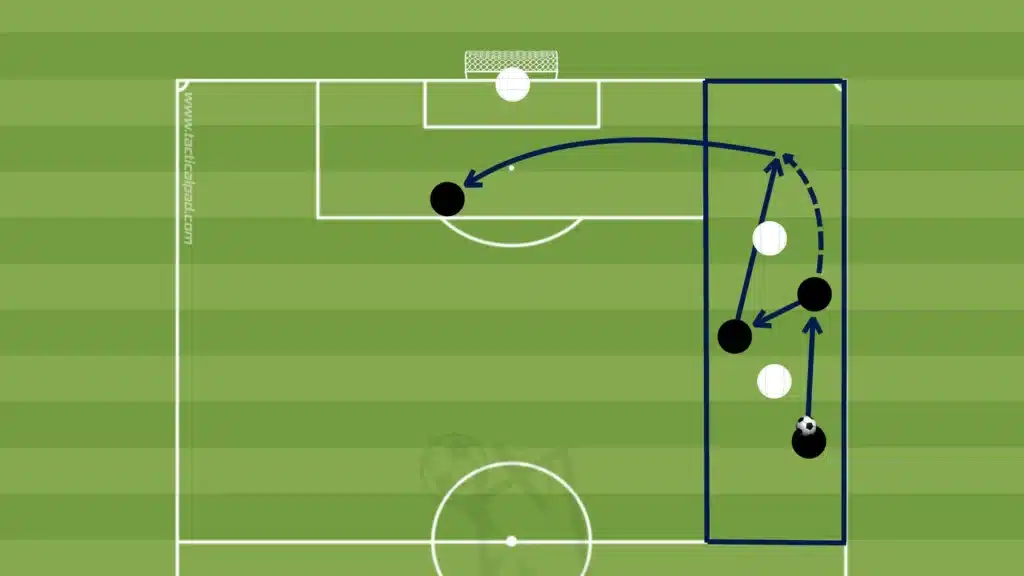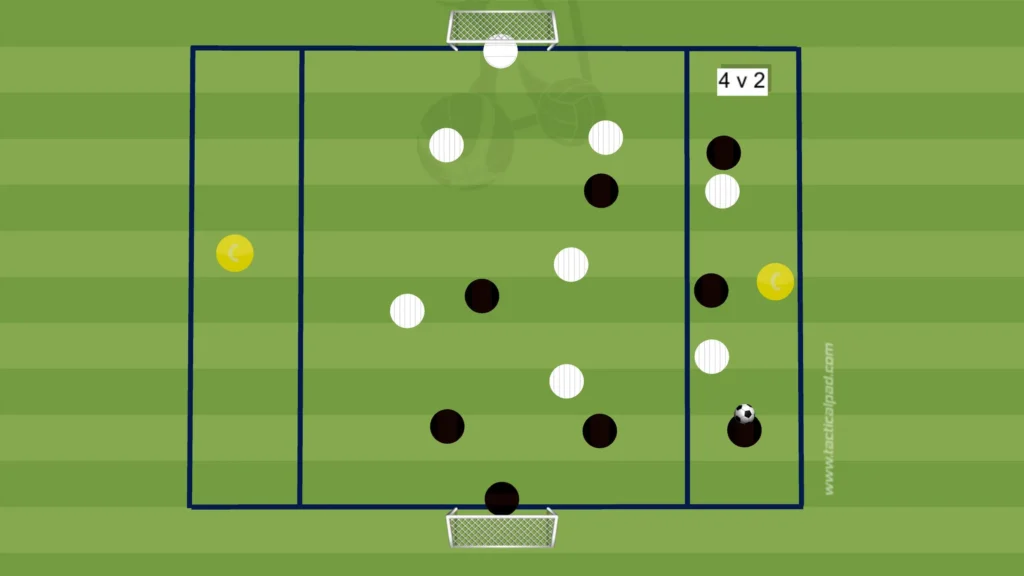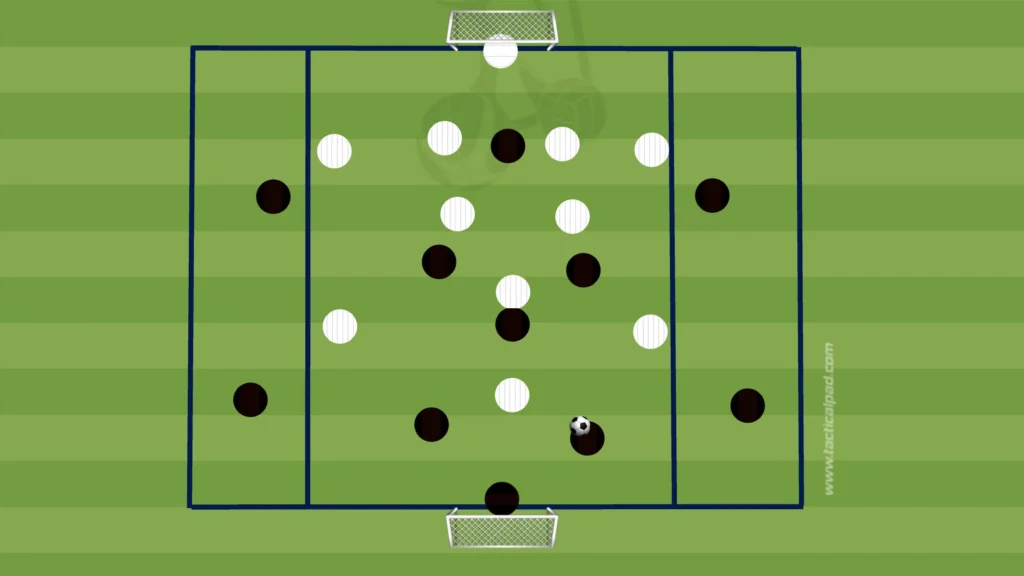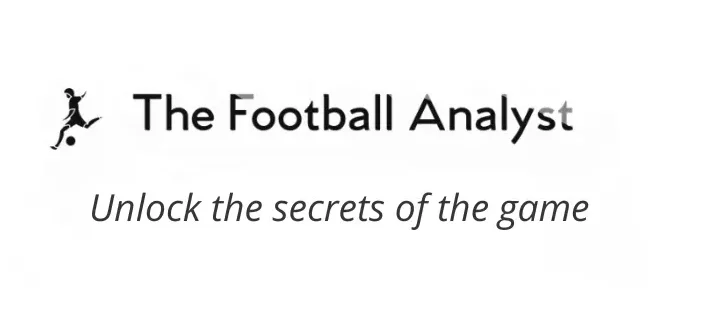In modern football, the ability to create numerical advantages in wide areas—especially in the final third—can be the difference between a sterile attack and a decisive goal-scoring opportunity. With compact defensive blocks becoming increasingly common, exploiting the flanks through well-structured wide overloads offers a valuable solution for disorganizing defensive units. This article outlines the principles behind wide overloads and presents effective training drills to develop this tactic in a structured, game-relevant way.
Why Wide Overloads Matter
1. Stretching Defensive Blocks
Most defensive systems aim to stay compact horizontally and vertically. By overloading the flanks, the attacking team forces the defending side to either shift out and open central lanes or stay compact and risk giving up 2v1 or 3v2 scenarios wide.
2. Isolating Defenders
Creating a wide overload on one side can isolate a fullback, forcing them into numerical inferiority or positional mistakes. This often results in space for a cut-back, cross, or third-man run.
3. Facilitating Cut-Back and Late Box Runs
Modern teams often prioritize low, fast crosses or cut-backs rather than traditional lofted balls. Wide overloads generate ideal angles and timing for these actions, especially when combined with coordinated runs from midfielders or opposite wingers.
Coaching Principles of Wide Overloads
To implement wide overloads effectively, coaches should train and emphasize:
- Positional Relationships: Coordinated movement between fullback, winger, and nearest central midfielder or striker.
- Third-Man Run: Breaking defensive lines with timing and disguise—crucial for exploiting the moment defenders shift.
- Timing and Angles: Players must recognize when to exploit the overload and when to recycle.
- Scanning and Communication: Recognizing numerical advantages early and signaling triggers for combinations.
Drill 1: 3v2 Wide Overload into Final Third
Objective:
Develop decision-making in wide 3v2 situations and transition into dangerous delivery zones.
Setup:
- Area: 20x15m wide channel near the final third.
- Attackers: Fullback (FB), Winger (W), Inside Midfielder (CM).
- Defenders: Opponent Fullback + Supporting Midfielder.
Instructions:
- Ball starts with FB or W.
- Attackers aim to combine to reach the final third and deliver a cross or cut-back.
- One-touch finish allowed for trailing striker (optional).
- Defenders aim to delay or win possession.

Coaching Points:
- Use third-man runs (e.g., FB overlaps, CM underlaps).
- Timing of movement to disorganize 2v2 and create 3v2.
- Scan for cut-back options or far-post delivery.
Drill 2: Wide Overload to Switch
Objective:
Create overload on one side to draw opponents and switch quickly to exploit weak-side space.
Setup:
- Half-pitch width. Two wide zones + central channel.
- 8v8 with neutral (wide attackers) in wide zones.
- Ball must pass through one wide zone before switching to the other.
Instructions:
- Teams build through the wide zones.
- Emphasis on overloading one side (e.g., W, F, CM) to pull opposition over.
- On coach’s command or naturally, execute fast switch to opposite wide zone.

Coaching Points:
- Positional play: hold width and depth.
- Patience in overload, then sudden switch.
- Fast ball circulation (1–2 touches).
- Opposite winger timing their arrival into the space.
Drill 3: Functional Final Third Game – Wide Overload with Crossing Zones
Objective:
Replicate match conditions with wide overloads leading to final actions (cross, cut-back, finish).
Setup:
- 11v11 or 9v9 on reduced pitch.
- Highlighted “crossing corridors” on both flanks.
- Bonus points/goals if a cross or cut-back originates from a wide overload (3v2 or more).
Instructions:
- Encourage overloads in wide corridors.
- Fullbacks and wingers must combine with midfielders or forwards.
- Finishing team earns points only if attack starts with successful overload in wide area.

Coaching Points:
- Recognize when overload is achieved.
- Quick interplay to enter danger zone.
- Occupation of box with at least 3 runners: near post, penalty spot, far post.
- Timing of late runs from midfield.
Key Takeaways for Coaches
- Structure the overloads: Don’t rely on spontaneous overlaps—build positional patterns and automations.
- Layer decision-making: Players must recognize when to overload, when to switch, and when to reset.
- Functional application: Drills must replicate match tempo, opposition pressure, and spatial constraints.
- Focus on final action: Overload is a means, not an end—finishing, delivery, and late runs complete the move.
Conclusion
Mastering wide overloads isn’t just about crowding one side—it’s about manipulating space, disorganizing defenses, and creating high-quality scoring chances. By embedding these drills into weekly microcycles and analyzing game footage, coaches can elevate their team’s capacity to dominate the final third through smart, intentional play on the flanks.
